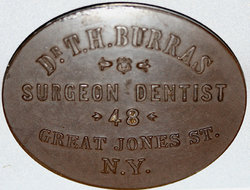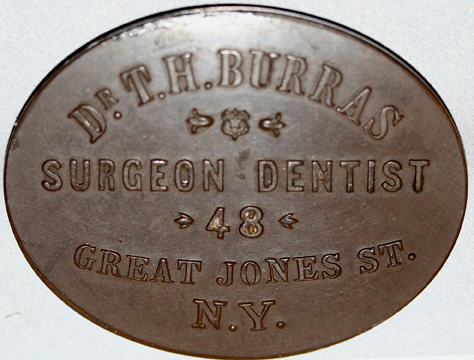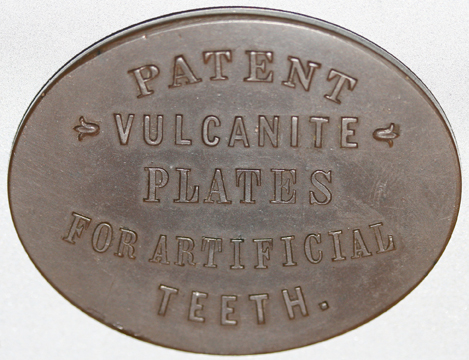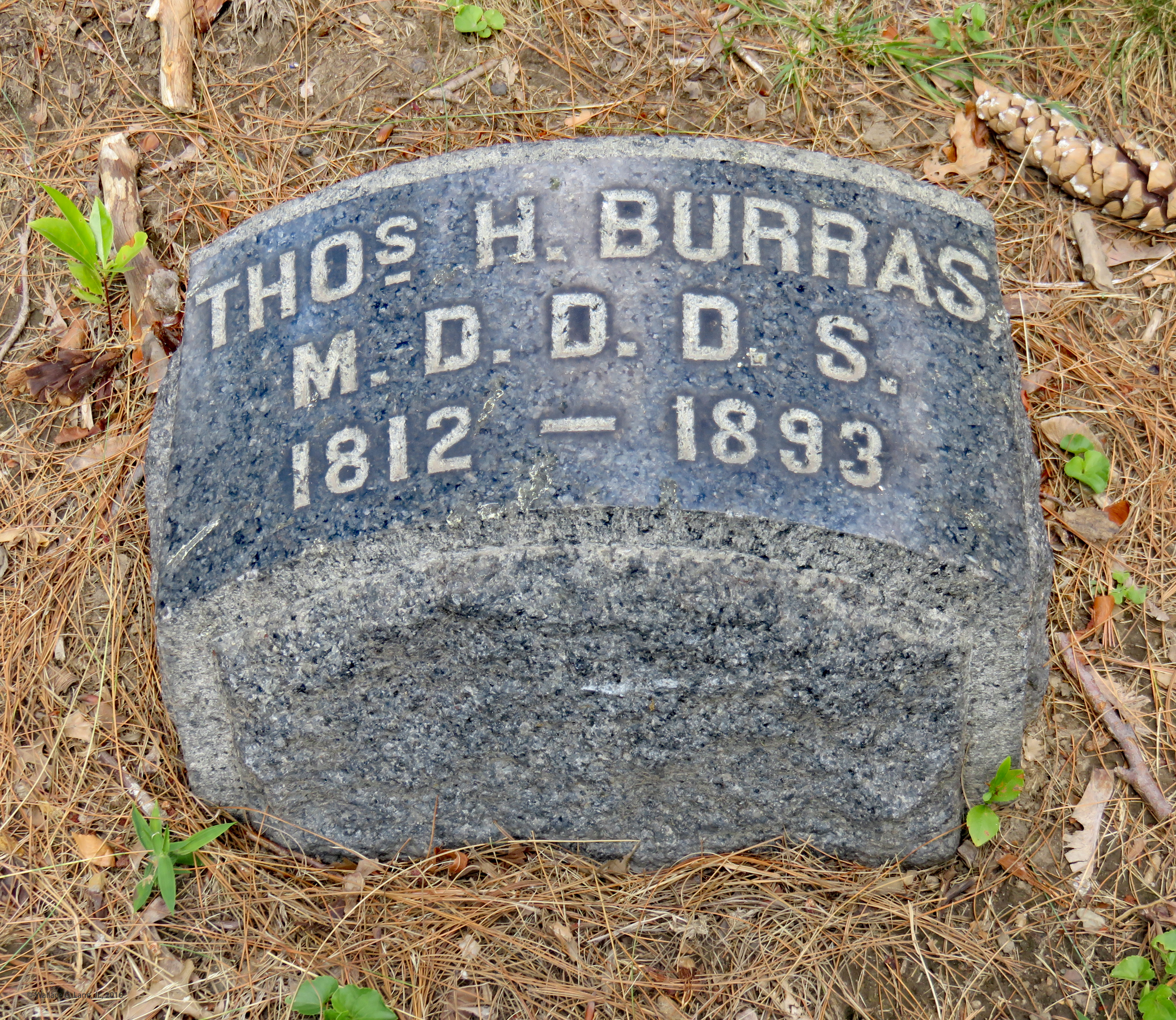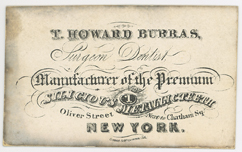Dr. T.H. Burras and the Vulcanite Murder Case. TAMS Journal, August, 1979.
Dr. T.H. Burras was, according to the writer of his obituary, "a genial man, and quite popular with all who knew him." Another source proclaimed him "full of intellectual and physical vigour." Possessing such attributes, it was only natural that, by 1858, he had introduced the use of Vulcanite, or hard rubber, into his dental practice, because it was in this application that Goodyear's invention was to make its greatest contribution to the relief of human suffering.
Porcelain teeth had become available for dentures early in the century, but the tedious and intricate process of mounting them into a metallic base made dentures quite beyond the reach of all but the wealthy. Worse, in the very year that Charles Goodyear received his first patent on Vulcanization (1844), Horace Wells had discovered anaesthesia. The magic of a few whiffs of laughing gas rapidly produced thousands of patients, and the magic of hard rubber as a denture was to prove an instant and economical solution to their handicap. And T.H. Burras, eminent and respected in his profession, was among its earliest and staunchest advocates.
Dr. Burras was born in 1812, in New York City. Upon graduating as a physician from the New York College of Medicine in 1831, he considered specialization in the eye and ear infirmary, "but concluded on reflection that, as individuals had but two eyes and two ears, and as every well developed specimen of humanity ought to be possessed of thirty-two teeth, and might ultimately require them to be replaced by dentures, I decided to choose my since much-loved profession of dental surgery." He opened a dental office on Oliver Street in 1837. In 1851 purchased a home and office at 48 Great Jones Street, where he remained until 1882. Then, after two years on Lexington Avenue, he retired to Long Island, where he died in 1893.
When, in 1860, the American Hard Rubber Company, owner of the Goodyear patents, decided to further stimulate the use of Vulcanite in dentistry, Dr. Burras became a major contributor to its publication, The VULCANITE, A Quarterly Journal devoted to the Science of Mechanical Dentistry. In that same year the company reported that enough Vulcanite had been sold to account for 42,000 cases at a total cost of $9,000, as contrasted to the $63,000 that it would have taken for gold denture bases, the former standard. The cost of the gold would have been minor, compared to the labor in fabrication of the dentures.
Sometime during the period 1851-1882, while Dr. Burras was on Great Jones Street, he issued a hard rubber token (Storer 3924a, 3938; Fuld 70A, B). The token is variously described as being red to maroon, and notes in The VULCANITE suggest that the denture-base pigment used was vermilion (cinnabar or mercuric sulphide). Difficulties occurred due to adulterated supplies of the pigment, and when the vulcanization was conducted at excessive temperatures. The term "surgeon dentist" used on the Burras token rapidly gave way to "dentist" after 1850, and had practically disappeared by 1870. A patent was issued in 1864 to John A. Cummings of Boston for the manufacture of Vulcanite dental plates, so that Burras' reference to PATENT VULCANITE PLATES doubtless refers to this, and places the token's manufacture shortly after that date. The Burras token, along with a hard rubber Higby & Stearns piece advertising stock teeth and dental foil (Storer 7859, Fuld 196A), appear to be the only hard rubber mementos of the long vulcanite period in American dental history.
But if this period was long, it was not peaceful. The Goodyear Dental Vulcanite Company expected to be paid a licensing fee and a royalty on each denture for the use of Vulcanite and the Cummings Patent (which they owned). Many dentists such as Dr. Burras accepted these terms, but most did not. Enforcement was difficult. In 1868 Josiah Bacon became treasurer of the company, and the nemesis of American dentistry. Agents, spies, detectives (including Pinkerton's), lawyers and courts were vigorously employed to bring infringers to justice, with little sign of mercy or public concern. Many dentists were ruined because they could not pay the fees, severe fines and judgements.
Among the "outlaw" dentists was Dr. Samuel P. Chalfont. He had been driven from practice on the East coast, and hounded from Philadelphia, Wilmington and St. Louis. Finally he was again discovered by Bacon's agents in dental practice in San Francisco. Bacon decided to make an example of him. Chalfont was nearly driven out of his mind by the grilling on the witness stand. After one particularly debilitating session he went to Bacon's hotel room in the evening. There he shot and killed him. It was a sensational case, and donations for Chalfont's defense poured in. Chalfont had become a hero and a martyr, but he spent ten years in San Quentin for his deed. Nevertheless, the persecution of the dental profession ceased, and two years later the Vulcanite dental plate patents expired.
The obituary for DR. T. H. BURRAS as reported in Dental Cosmos, Volume 35, Issue: 4, April, 1893, pp. 328-329.
DIED, at Patchogue, Long Island, N.Y., March 6, I893, of heart-failure, T.H. BURRAS, M.D., M.D.S., in the eighty-first year of his age.
Dr. Burras was born in Varick street, New York city, April 6, I812. He was a graduate of the New York College of Medicine, and commenced practice as a physician with Dr. Benjamin Kissam, of New York, in 1831 [probably Benjamin Roosevelt Kissam (1792-1861, FAG Memorial# 74909098)]. Turning his attention to dentistry, he opened an office for the practice of that specialty in Oliver street in I837. In I851 he purchased a home on Great Jones street, and remained there until 1882, when he removed to Lexington avenue for two years. Thus it will be seen that he was one of the oldest dental practitioners of New York, and years ago he became well known to the profession throughout the city and state. He retired to Patchogue in 1884.
Dr. Burras married Mary E. Hawkens, of New York, in 1839. She died about one year ago. They had three children, one son and two daughters, all of whom survive them. The doctor was a genial man, and quite popular with all who knew him. His reminiscences of old New York were often of great interest. His remains will be finally interred at Greenwood.
Dr. T.H. Burras and the Vulcanite Murder Case. TAMS Journal, August, 1979.
Dr. T.H. Burras was, according to the writer of his obituary, "a genial man, and quite popular with all who knew him." Another source proclaimed him "full of intellectual and physical vigour." Possessing such attributes, it was only natural that, by 1858, he had introduced the use of Vulcanite, or hard rubber, into his dental practice, because it was in this application that Goodyear's invention was to make its greatest contribution to the relief of human suffering.
Porcelain teeth had become available for dentures early in the century, but the tedious and intricate process of mounting them into a metallic base made dentures quite beyond the reach of all but the wealthy. Worse, in the very year that Charles Goodyear received his first patent on Vulcanization (1844), Horace Wells had discovered anaesthesia. The magic of a few whiffs of laughing gas rapidly produced thousands of patients, and the magic of hard rubber as a denture was to prove an instant and economical solution to their handicap. And T.H. Burras, eminent and respected in his profession, was among its earliest and staunchest advocates.
Dr. Burras was born in 1812, in New York City. Upon graduating as a physician from the New York College of Medicine in 1831, he considered specialization in the eye and ear infirmary, "but concluded on reflection that, as individuals had but two eyes and two ears, and as every well developed specimen of humanity ought to be possessed of thirty-two teeth, and might ultimately require them to be replaced by dentures, I decided to choose my since much-loved profession of dental surgery." He opened a dental office on Oliver Street in 1837. In 1851 purchased a home and office at 48 Great Jones Street, where he remained until 1882. Then, after two years on Lexington Avenue, he retired to Long Island, where he died in 1893.
When, in 1860, the American Hard Rubber Company, owner of the Goodyear patents, decided to further stimulate the use of Vulcanite in dentistry, Dr. Burras became a major contributor to its publication, The VULCANITE, A Quarterly Journal devoted to the Science of Mechanical Dentistry. In that same year the company reported that enough Vulcanite had been sold to account for 42,000 cases at a total cost of $9,000, as contrasted to the $63,000 that it would have taken for gold denture bases, the former standard. The cost of the gold would have been minor, compared to the labor in fabrication of the dentures.
Sometime during the period 1851-1882, while Dr. Burras was on Great Jones Street, he issued a hard rubber token (Storer 3924a, 3938; Fuld 70A, B). The token is variously described as being red to maroon, and notes in The VULCANITE suggest that the denture-base pigment used was vermilion (cinnabar or mercuric sulphide). Difficulties occurred due to adulterated supplies of the pigment, and when the vulcanization was conducted at excessive temperatures. The term "surgeon dentist" used on the Burras token rapidly gave way to "dentist" after 1850, and had practically disappeared by 1870. A patent was issued in 1864 to John A. Cummings of Boston for the manufacture of Vulcanite dental plates, so that Burras' reference to PATENT VULCANITE PLATES doubtless refers to this, and places the token's manufacture shortly after that date. The Burras token, along with a hard rubber Higby & Stearns piece advertising stock teeth and dental foil (Storer 7859, Fuld 196A), appear to be the only hard rubber mementos of the long vulcanite period in American dental history.
But if this period was long, it was not peaceful. The Goodyear Dental Vulcanite Company expected to be paid a licensing fee and a royalty on each denture for the use of Vulcanite and the Cummings Patent (which they owned). Many dentists such as Dr. Burras accepted these terms, but most did not. Enforcement was difficult. In 1868 Josiah Bacon became treasurer of the company, and the nemesis of American dentistry. Agents, spies, detectives (including Pinkerton's), lawyers and courts were vigorously employed to bring infringers to justice, with little sign of mercy or public concern. Many dentists were ruined because they could not pay the fees, severe fines and judgements.
Among the "outlaw" dentists was Dr. Samuel P. Chalfont. He had been driven from practice on the East coast, and hounded from Philadelphia, Wilmington and St. Louis. Finally he was again discovered by Bacon's agents in dental practice in San Francisco. Bacon decided to make an example of him. Chalfont was nearly driven out of his mind by the grilling on the witness stand. After one particularly debilitating session he went to Bacon's hotel room in the evening. There he shot and killed him. It was a sensational case, and donations for Chalfont's defense poured in. Chalfont had become a hero and a martyr, but he spent ten years in San Quentin for his deed. Nevertheless, the persecution of the dental profession ceased, and two years later the Vulcanite dental plate patents expired.
The obituary for DR. T. H. BURRAS as reported in Dental Cosmos, Volume 35, Issue: 4, April, 1893, pp. 328-329.
DIED, at Patchogue, Long Island, N.Y., March 6, I893, of heart-failure, T.H. BURRAS, M.D., M.D.S., in the eighty-first year of his age.
Dr. Burras was born in Varick street, New York city, April 6, I812. He was a graduate of the New York College of Medicine, and commenced practice as a physician with Dr. Benjamin Kissam, of New York, in 1831 [probably Benjamin Roosevelt Kissam (1792-1861, FAG Memorial# 74909098)]. Turning his attention to dentistry, he opened an office for the practice of that specialty in Oliver street in I837. In I851 he purchased a home on Great Jones street, and remained there until 1882, when he removed to Lexington avenue for two years. Thus it will be seen that he was one of the oldest dental practitioners of New York, and years ago he became well known to the profession throughout the city and state. He retired to Patchogue in 1884.
Dr. Burras married Mary E. Hawkens, of New York, in 1839. She died about one year ago. They had three children, one son and two daughters, all of whom survive them. The doctor was a genial man, and quite popular with all who knew him. His reminiscences of old New York were often of great interest. His remains will be finally interred at Greenwood.
